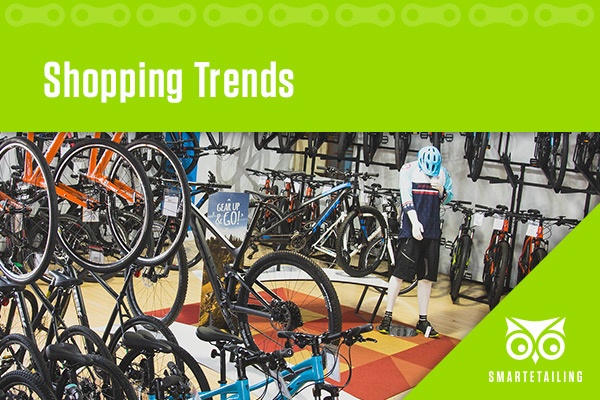
The cycling industry is somewhat unique in that it’s one of the few remaining markets primarily grounded in brick and mortar. People still like to see, touch and experience the products we sell in person. This leads many bike shop owners to feel that having an online presence isn’t really worth it, or that the online game is being played by someone other than them.
When we talk to bike shop owners for the first time it is common for them to say, "I can't compete online so I'm not going to try." Our response? Change your perspective. You aren’t competing to try to be a better pure-play ecommerce retailer than the Jenson USA or Wiggle. You are competing for a share of your local shoppers' spending and you want to meet that shopper where they are wanting to buy.
It's Not Online Sales. It's Just Sales.
The truth is, ecommerce and physical retail have become much more intertwined than you may realize and, more importantly, it’s not just about buying online. In fact, according to a recent study by Deloitte, $0.56 of every dollar spent in a physical store is influenced by some type of digital interaction.
What it all boils down to is one simple action: shopping. And despite the fact that the avenues have changed dramatically over the past few decades, the two fundamental components of shopping remain the same.
- Shopping is first browsing (the process of discovery)
- Then buying (making the purchase)
This has been the case since the dawn of the modern era.
Discovery Process Has Evolved
What's changed, however, is how that first step - discovery - is performed. Thanks to technology's widespread availability and ease-of-use, 67% of today’s consumers conduct product research online before stepping foot in a physical store. In other words, the vast majority of your clientele will begin the buying journey online before they show up at your door.
If you aren't accounting for this, you are most certainly missing out on business as a result.
The fact is, consumer behavior and demand have evolved and that means evolution is necessary for retailers as well. In order to compete in today's digital landscape, stores (even exclusively brick and mortar ones) must adapt to deliver the relevant information that consumers are looking for online, such as product specifications, detailed descriptions, reviews and product demos.
If the stats above aren’t enough to convince you, here are a few key advantages an online presence can have for your physical store.
Greater Reach
The goal of any marketing strategy is reaching as many prospective relevant customers as possible. The web offers unprecedented access to a pool of potential leads far greater than what you could reach via conventional methods of waiting for a shopper to walk through your door. Showing shoppers who are in the discovery process your products online helps introduce those local shoppers to the fact that you can meet their needs. They are more likely to either purchase from you online for free in-store pickup or simply walk through your door ready to buy.
Strengthened Reputation
Did you know that 65% of people view online search results as the most trusted source of information about a business? That’s a higher level of trust than any other source, either online or offline. What's more, 90% of today’s consumers check online reviews before visiting a business and 67% say those reviews influence their purchasing decisions. Being present online and maintaining a strong, positive reputation can dramatically improve your chances of converting leads into paying customers. Most bike shops today have a website, but does that website answer all of a shopper's questions? Most importantly, what does this business sell, at what price, and is it available.
Always Available
It’s highly unlikely that your bike shop is open 24/7, but what if a customer has a question after hours? The beauty of having a website with your product information, pricing, and availability for your brick and mortar store is that it's always open and available. The ability to browse online at their leisure and convenience can improve your customer experience, which can lead to repeat business and valuable word-of-mouth marketing.
Better Bottom Line
If you're starting to panic about the rise of ecommerce, you can relax a little because 94% of total retail sales are still generated through brick and mortar stores. But since the majority of today’s shoppers begin their journey online, ensuring that your bike shop is present and offers the information your prospects are looking for is essential to turning those clicks into in-store purchases. Obviously, the more people you reach and influence via online channels, the more traffic your physical store will receive, which translates to more revenue in your pocket.
Join the Club
Finally, being present online is important because it’s where your customers and your competitors already are. When a prospect goes online to research a particular bike or bike part and the shop across town is what pops up, where do you think that lead is going to ultimately end up when it comes time to make a purchase? To compete in today’s digital marketplace, you simply must be present where your clientele are, and that's on the web, plain and simple.
Like it or not, shopping has changed and with the number of consumers turning to the web to start their buying journey, having an active online presence is no longer an option but a necessity. SmartEtailing can develop a dynamic website for your bike shop that is expertly designed to help you stand out from the competition and leverage the power of the internet to increase sales. Click here to request a demo or contact us for more information.

Comments